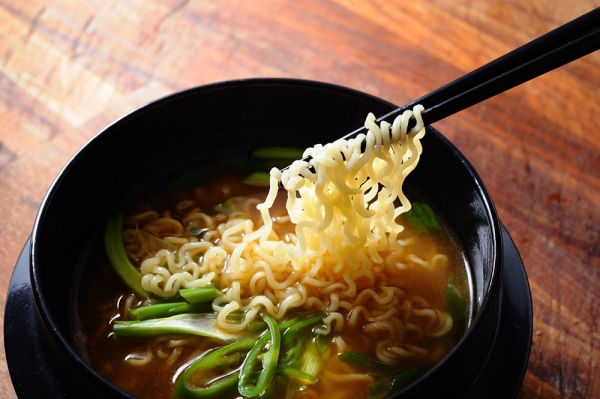Promotional Features
How to meet Asia’s demanding food texture preferences in a fast-changing market
Cargill’s Modified tapioca starches can help create noodles, meat, and mochi-style bakery with desired textures
Texture is critical to food across Asia. From the jelly-like bite of Korean naengmyeon noodles, to the meaty texture of Chinese lap cheong sausages, and the unique chewy mouthfeel of Japanese mochi balls, Asian foods are defined as much by physical sensations as taste. Traditionally, such textures are found in freshly prepared foods, but the rise of at-home delivery and consumption is driving brands to replicate favored mouthfeels in new contexts. Cargill is helping food brands rise to that challenge.
By imbuing products with sought-after textures, food brands can give consumers heightened, more indulgent sensory experiences and, in some cases, imply superior product quality. However, the rise in consumer interest in texture is happening at the same time as market shifts that make it harder to make the mouthfeel of products consistent and desirable.
Asian food consumption is changing
Traditionally, people across Asia have accessed the textural experiences they desire in fresh cooking and foodservice. That is changing quickly. The number of people in Asia using online food delivery services is growing at around 25% a year.5 Revenues are increasing faster still. The rise is happening in parallel to increasing consumption of prepared meals such as frozen foods that only need heating at home.
The shift in consumption habits, which is being accelerated by the coronavirus crisis, is making it hard to give consumers the texture they want. Textures that are easily achieved in fresh cooking can be hard to replicate in prepared meals and home-delivered dishes.
Consumer demand for healthier alternatives is also creating texture challenges. One survey found 75% of people in Malaysia want food companies to tweak their recipes to make products healthier, but only if they can reformulate foods without sacrificing texture and other sensory properties.6
The changing economics of Asia suggest a growing number of people will refuse to tolerate products that fall short of the textural expectations. By 2022, another 50 million people in Indonesia, Malaysia, the Philippines, Thailand, and Vietnam are tipped to become middle class, creating a pool of consumers with $300 billion in disposable income.7
Using tapioca to build back texture
Modified tapioca starch can help companies meet consumer texture expectations. As a non-GMO botanical with unique textural properties such as chewiness, springiness and a clean taste profile, tapioca is well suited to addressing the problems food brands face in the region today.
With the rise of the middle class driving the rapid expansion of food delivery services, key categories such as instant noodles are being transformed. The traditional category drivers of convenience, flavor, and affordability remain relevant, but other factors such as health considerations and the rise of home delivery are now also shaping the sector.
Noodles
Noodle restaurants that are switching to home delivery are discovering that noodles go soggy when they are added to the broth before the order is driven to the buyer. The ingredients and processes that worked in the foodservice world no longer give the desired texture when the dish is eaten off site.
Pressure to make noodles healthier is creating further textural challenges. For example, Singapore’s Health Promotion Board is targeting a five-fold increase in consumption of wholegrain noodles.8 The switch from plain to wholemeal flour, while superficially straightforward, will affect the texture of the noodles.
In that environment, brands need to innovate to capture value while contending with the challenge of meeting conflicting consumer demands. For example, the use of wholegrain flour to make noodles healthier negatively affects dough sheetability and results in finished products that lack the springy, chewy texture consumers desire.
Modified tapioca starch can help brands overcome such challenges by building back texture lost as a result of changes to consumption habits and product recipes, thereby enabling them to consistently deliver what consumers want.
Meat
Meat poses its own set of texture challenges, particularly when packaged in convenience foods designed to be heated by consumers at home. The length and nature of supply chains means such foods can go through multiple freeze-thaw cycles before they are eaten, causing the texture to change significantly between the product being made and consumed.
Repeated freeze-thaw cycles compromise the meat emulsion of sausages, exacerbating existing textural issues linked to the use of fatty or mechanically deboned meat. The use of such meat can reduce the springiness of sausages.
Modified tapioca starch can fix those issues. Chik Liang Tan, Segment Director for Texturizers and Specialties at Cargill, explained the role the starch plays in the texture of frozen meat and other convenience foods.
“Modified tapioca starches can help improve and sustain the texture of frozen food such as frozen gyoza, frozen noodles, frozen meat etc., which often go through three to seven freeze-thaw cycles from manufacturing to consumption. Our products can help to hold the water in the meat and maintain its fresh texture for longer,” Chik Liang said.
Conclusion
The breadth of Cargill's offering, which spans well beyond any single application or customer need, and associated expertise enable it to provide everything brands need to build back texture into noodles, meat and other products.
“We can truly understand the challenges our customers face in terms of texture. And with the width of our offerings in texturizers including modified starches, stabilizer systems, hydrocolloids etc., we are in a strong position to solve challenging texture problems across applications,” Gaetan Heynderickx, Technical Director for Cargill’s Food Ingredients and Bio-Industrial business in Asia, said.
By partnering with Cargill, which has five innovation centers in Asia, food companies access the complete range of solutions they need to tackle challenging problems across all applications, equipping them to create products such as noodles, sausages, and mochi that meet consumer expectations, regardless of the setting in which they are consumed.
References
1. Millennials are a core target for textural innovation - Innova Market Insights. Innova Market Insights https://www.innovamarketinsights.com/millennials-are-a-core-target-for-textural-innovation/ (2020).
2. From fermented bubbles to crispy fruit: Texture will be 2018’s top trend, says Mintel. FoodNavigator-Asia (2017).
3. Innova Market Insights. Top Ten Trends for 2020.
4. Pellegrino, R. et al. The contribution of texture contrasts and combinations to food acceptance across cultures. J. Texture Stud. 51, 225–231 (2020).
5. Online Food Delivery - Asia | Statista Market Forecast. Statista https://www.statista.com/outlook/374/101/online-food-delivery/asia.
6. Healthier Product Reformulation in Malaysia. https://foodindustry.asia/documentdownload.axd?documentresourceid=31379.
7. Understanding Southeast Asia’s Emerging Middle Class. Bain
https://www.bain.com/insights/understanding-southeast-asias-emerging-middle-class/ (2019).
8. Push for wholegrain noodles to be more widely available. CNA (2017).





